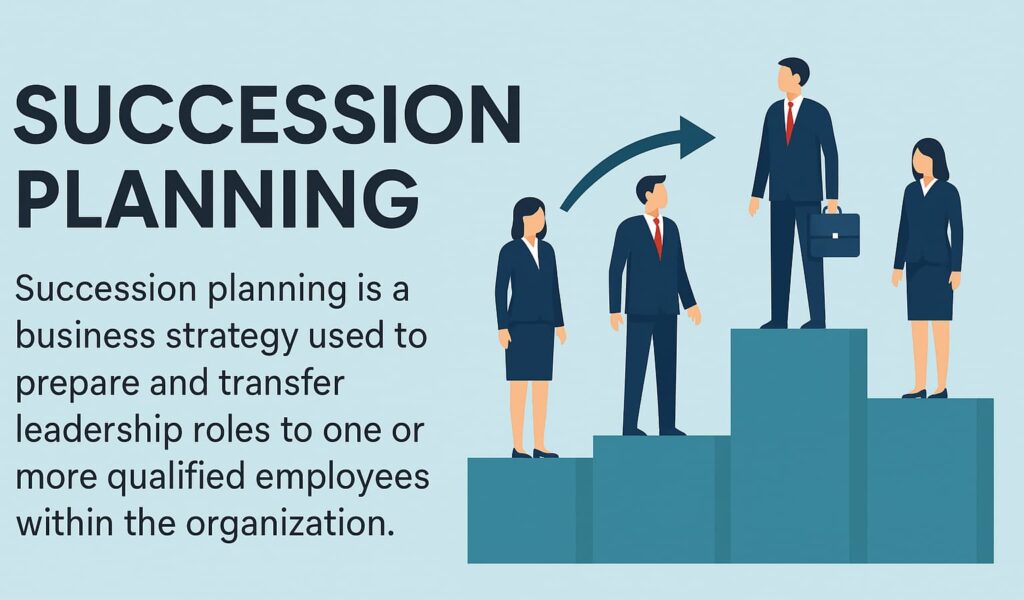CONTENTS
- Introduction to Succession Planning
- The Strategic Importance of Succession Planning
- Aligning with business goals and long‑term vision
- How succession planning supports organizational resilience
- Key Elements of a Robust Succession Plan
- Identifying high‑potential employees
- Competency models and addressing skill gaps
- The Role of Leadership and HR in Succession Planning
- Leadership development and mentorship
- HR’s role in implementing and sustaining plans
- Challenges in Succession Planning
- Common obstacles and how to address them
- Balancing short‑term needs with long‑term planning
- Diversity, Inclusion, and Cultural Considerations
- Ensuring equity in leadership pipelines
- Addressing cultural dynamics in global organizations
- Technology and Analytics in Succession Planning
- Leveraging HR tech for data‑driven decisions
- Trends in AI and automation to enhance processes
- Lessons from Succession Planning Case Studies
- Key insights from successful and failed implementations
- Practical examples and takeaways for improvement
- Future Trends in Succession Planning
- Preparing for workforce changes and evolving organizational needs
- Anticipating the impact of globalization and technology
- Conclusion
INTRODUCTION
In today’s fast‑evolving business landscape, succession planning is essential for ensuring long‑term stability and leadership continuity. It involves identifying and preparing future leaders to step into key roles, minimizing disruptions during transitions.
Beyond emergency preparedness, succession planning is now a core component of strategic workforce management. Companies that invest in leadership development are better positioned to adapt to market changes, technological advancements, and competitive pressures. A strong succession plan fosters a culture of growth, innovation, and readiness at all levels.
Diversity and inclusion are also critical in modern succession strategies. Organizations benefit from leadership pipelines that reflect diverse backgrounds, driving innovation and improving decision‑making. However, challenges remain, including balancing immediate operational needs with long‑term leadership development, closing skill gaps, and ensuring a fair, transparent selection process.
This paper explores the significance of succession planning, practical implementation strategies, common obstacles, and the role of technology in shaping future leadership development. Through real‑world case studies and expert insights, it highlights how businesses can build a strong, future‑ready leadership pipeline.

The Strategic Importance of Succession Planning
Succession planning is crucial for ensuring smooth leadership transitions and business continuity. By identifying and developing future leaders, organizations can maintain stability and competitiveness.
Ensuring Leadership Continuity
Unplanned leadership changes can disrupt operations. A structured succession plan turns these transitions into controlled processes, ensuring business functions continue smoothly.
Mitigating Risks from Leadership Gaps
Vacancies in key roles can cause delays and costs. Succession planning prepares internal talent to step up, reducing downtime and the impact of leadership gaps.
Enhancing Employee Growth and Retention
A strong succession plan promotes employee growth through development programs, ensuring a merit‑based process for selecting future leaders.
Safeguarding Institutional Knowledge
Succession planning preserves valuable institutional knowledge by transitioning expertise to well‑prepared successors, maintaining business continuity.
Aligning Talent Development with Strategic Goals
Succession planning aligns leadership development with organizational goals, ensuring future leaders can drive growth and adapt to challenges.
Summary
Succession planning ensures leadership continuity, reduces risks from leadership gaps, supports employee growth, protects institutional knowledge, and aligns talent with long‑term goals, helping organizations navigate leadership transitions and achieve sustained success.
Key Elements of a Robust Succession Plan
Succession planning is a proactive strategy that ensures leadership continuity and organizational stability. A well‑structured plan consists of several key components that help businesses navigate leadership transitions effectively.
- Alignment with Business Goals
A strong succession plan aligns with long‑term company objectives, focusing on critical roles that drive success. - Identifying Key Positions
Not all roles require succession planning. Prioritizing executive and specialized positions ensures minimal disruption during transitions. - Assessing Internal Talent
Performance reviews and leadership assessments help identify employees with high potential and pinpoint skill gaps for targeted development. - Tailored Development Plans
Future leaders benefit from customized HR trainings, mentorship, and cross‑functional experiences to build necessary competencies. - Transparency and Inclusivity
A fair, well‑communicated process fosters trust and ensures diverse talent has equal opportunities for leadership roles. - Leveraging Technology and Analytics
HR software and predictive analytics provide data‑driven insights, reducing bias and improving decision‑making in succession planning. - Leadership Involvement
Active participation from top management in mentoring and development ensures alignment with business priorities. - Continuous Review and Adaptation
Regular assessments keep the plan relevant, adapting to changes in market trends, business growth, and technological advancements. - Integration with Workforce Planning
Succession planning should complement broader talent management strategies, ensuring a well‑prepared leadership pipeline. - Cultural Fit and Organizational Values
Beyond technical skills, future leaders should embody company values and contribute to a cohesive organizational culture.
By implementing these elements, organizations can build a strong, future‑ready leadership framework that supports long‑term growth and resilience.
The Role of HR and Leadership in Succession Planning
The Role of Leadership in Succession Planning
- Strategic Alignment
Leaders are responsible for aligning succession planning with the organization’s long‑term objectives. By identifying future leadership requirements, they ensure that the succession plan supports the company’s strategic direction. - Mentorship and Development
Senior leaders serve as mentors, guiding potential successors through professional development. This mentorship is crucial for transferring knowledge and fostering the skills necessary for future leadership roles. - Cultivating a Leadership Culture
By promoting a culture that values leadership development, current leaders encourage employees to pursue growth opportunities, thereby strengthening the internal talent pipeline. - Decision‑Making and Oversight
Leaders play a critical role in identifying key positions and evaluating potential successors, ensuring that the most qualified individuals are prepared to assume leadership roles when needed.

The Role of Human Resources in Succession Planning
- Talent Identification and Assessment
HR collaborates with leadership to identify high‑potential employees and assess their readiness for advancement. This involves evaluating performance, competencies, and potential for growth. - Development Programs Implementation
HR designs and implements tailored development programs to prepare identified talent for future roles. These programs may include training, coaching, and rotational assignments. - Performance Management
By establishing robust performance management systems, HR ensures that employees receive regular feedback and evaluations, facilitating continuous development. - Retention Strategies
HR develops and implements strategies to retain top talent, such as competitive compensation packages, career development opportunities, and employee engagement initiatives. - Diversity and Inclusion
Ensuring diversity and inclusion within succession planning is a key responsibility of HR. By promoting a diverse leadership pipeline, HR enhances organizational innovation and decision‑making.
Challenges in Succession Planning
Succession planning is essential for organizations to maintain leadership continuity and operational stability. However, several challenges can hinder its success. Here’s an overview of these obstacles:
- Identifying Potential Successors
Finding individuals with the right skills and qualifications for key roles can be difficult, especially in smaller organizations with limited talent pools. Some employees may also lack interest in leadership roles, making the identification process more challenging. - Lack of Communication and Collaboration
Succession planning requires clear communication between management and employees. Without this, employees may not understand the plan’s importance or feel involved, which can reduce support for its success. - Insufficient Resources
Executing a succession plan demands considerable time and effort. Organizations, particularly smaller ones, may face limitations in manpower and finances, which can impact resource allocation for effective planning. - Resistance from Stakeholders
Stakeholders may resist succession planning due to fear of change or threats to their positions. This resistance can obstruct the development and execution of the plan, especially if key individuals are unwilling to support it. - Lack of Diversity
Limited diversity in the talent pool can undermine succession planning by preventing varied leadership perspectives, which are essential for innovation and adaptability. - Inadequate Succession Planning Tools
Outdated tools, limited data analytics, and insufficient HR support can hinder the effectiveness of succession planning, preventing organizations from executing their plans properly. - Lack of Employee Engagement and Buy‑In
When employees feel excluded or undervalued, their motivation to engage in succession planning drops, leaving organizations with a shallow talent pipeline and fewer future leaders.
Overcoming these challenges requires strategic actions such as clear communication, resource allocation, stakeholder involvement, diversity initiatives, and the use of modern tools. Addressing these obstacles ensures a robust succession plan that promotes long‑term leadership and organizational success.
Diversity, Inclusion, and Cultural Consideration
In today’s global business environment, organizations must integrate diversity, inclusion, and cultural awareness into their succession planning strategies. A well‑rounded leadership team that represents different backgrounds and perspectives not only enhances decision‑making but also fosters innovation and business growth.
Enhancing Innovation and Performance
Diverse leadership teams bring unique viewpoints that lead to better problem‑solving and creative solutions. Companies that prioritize diversity in leadership see improved financial performance and employee engagement.

Reflecting Market Demographics
Leadership should reflect the diversity of the workforce and customer base. A leadership team that understands various cultural needs can drive better market engagement and brand loyalty.
Developing Inclusive Selection Criteria
To avoid unconscious bias, companies must create clear, competency‑based selection criteria that emphasize diverse experiences, skills, and leadership styles rather than relying on traditional promotion patterns.
Cultural Sensitivity in Leadership Transitions
Succession plans should consider cultural factors such as leadership expectations, communication styles, and decision‑making hierarchies. This ensures smooth transitions, especially in multinational organizations.
By embedding diversity and inclusion in succession planning, businesses can build strong, representative leadership teams that drive long‑term success and workplace equity.
Technology and Analytics in Succession Planning
The integration of technology and data analytics has transformed succession planning by making leadership development more data‑driven, efficient, and predictive. Companies leveraging these tools can better identify high‑potential employees, assess leadership readiness, and mitigate risks associated with leadership transitions.
- Identifying High‑Potential Employees with AI
Artificial intelligence (AI) and machine learning analyse employee performance, engagement, and skills to identify future leaders objectively, reducing bias in the selection process. - Predictive Analytics for Leadership Readiness
Data analytics tools help forecast leadership gaps and succession risks, allowing organizations to plan for smooth transitions. Predictive models assess trends in employee performance, career progression, and industry benchmarks. - Automated Development and Training Programs
Learning management systems (LMS) and AI‑driven career pathing tools personalize leadership development, ensuring potential successors acquire the necessary skills before assuming key roles. - Real‑Time Performance Tracking
HR analytics dashboards provide continuous insights into employee growth, leadership competency, and readiness for advancement. These systems help HR professionals make informed succession planning decisions.
By utilizing technology and analytics, organizations can make succession planning more strategic, data‑backed, and aligned with long‑term business objectives.
Lessons from Succession Planning Case Studies
Examining real‑world succession planning case studies provides valuable insights into best practices, challenges, and strategies for leadership transition. Successful organizations focus on long‑term talent development, adaptability, and proactive planning.
- Apple: Planned Leadership Transition
Apple’s transition from Steve Jobs to Tim Cook is a textbook example of effective succession planning. Cook was groomed for leadership over several years, ensuring stability and continuity. - GE: Leadership Development as a Strategy
General Electric (GE) has a long‑standing tradition of cultivating leaders internally, with a structured program that ensures a strong pipeline of executives. This approach has made leadership transitions smoother. - McDonald’s: Addressing Unplanned Transitions
McDonald’s faced leadership challenges when its CEO, Steve Easterbrook, had to step down unexpectedly. The company successfully implemented an emergency succession plan, promoting a qualified internal candidate. - IBM: Adapting to Market Changes
IBM’s leadership transitions have focused on aligning executive talent with technological advancements, ensuring that successors are equipped to lead in changing business environments.
Key Takeaways:
- Groom Internal Talent: Companies like GE and Apple show that long‑term leadership development leads to smoother transitions.
- Have Contingency Plans: McDonald’s highlights the importance of being prepared for unexpected changes.
- Adapt Leadership to Market Trends: IBM’s approach demonstrates that leadership should evolve alongside industry advancements.
By learning from these cases, organizations can refine their own succession planning strategies to ensure stability, resilience, and growth.
Future Trends in Succession Planning
Succession planning is evolving with advancements in technology and a growing emphasis on diversity, employee engagement, and strategic workforce development. The following trends are shaping the future of leadership transitions:
- AI‑Driven Talent Identification
Artificial intelligence (AI) and machine learning analyze employee data, skills, and performance to identify potential leaders. These tools reduce bias and improve accuracy in leadership selection. - Virtual Reality (VR) for Leadership Training
Organizations are using VR simulations to immerse future leaders in realistic decision‑making scenarios, improving their ability to handle complex challenges. - Predictive Analytics for Workforce Planning
Big data and predictive analytics help forecast leadership gaps, skill shortages, and succession risks, allowing organizations to plan proactively. - Crowdsourced Leadership Development
Companies are increasingly using employee feedback and peer assessments to identify high‑potential candidates, fostering a more inclusive approach to succession planning. - Personalized Leadership Development Plans
Rather than a one‑size‑fits‑all approach, businesses are focusing on customized training and development programs tailored to individual career paths.
By embracing these trends, organizations can ensure a more strategic, data‑driven, and adaptable approach to succession planning, building a strong leadership pipeline for the future.
Conclusion
Succession planning is crucial for leadership continuity, business stability, and long‑term growth. By identifying and developing future leaders, organizations can reduce risks, preserve institutional knowledge, and stay competitive.
Technology and data analytics have transformed succession planning, making it more efficient and objective. AI‑driven assessments, predictive analytics, and virtual training enhance leadership development, while diversity and inclusion initiatives ensure fair opportunities.
Despite challenges like resistance to change and leadership gaps, companies can address them with structured workforce planning and data‑driven strategies. Looking ahead, AI‑driven talent assessments and immersive training will continue shaping succession planning.
Ultimately, effective succession planning is an ongoing process that requires strategic vision and adaptability. Organizations that invest in it will be better prepared for future leadership transitions and long‑term success.

